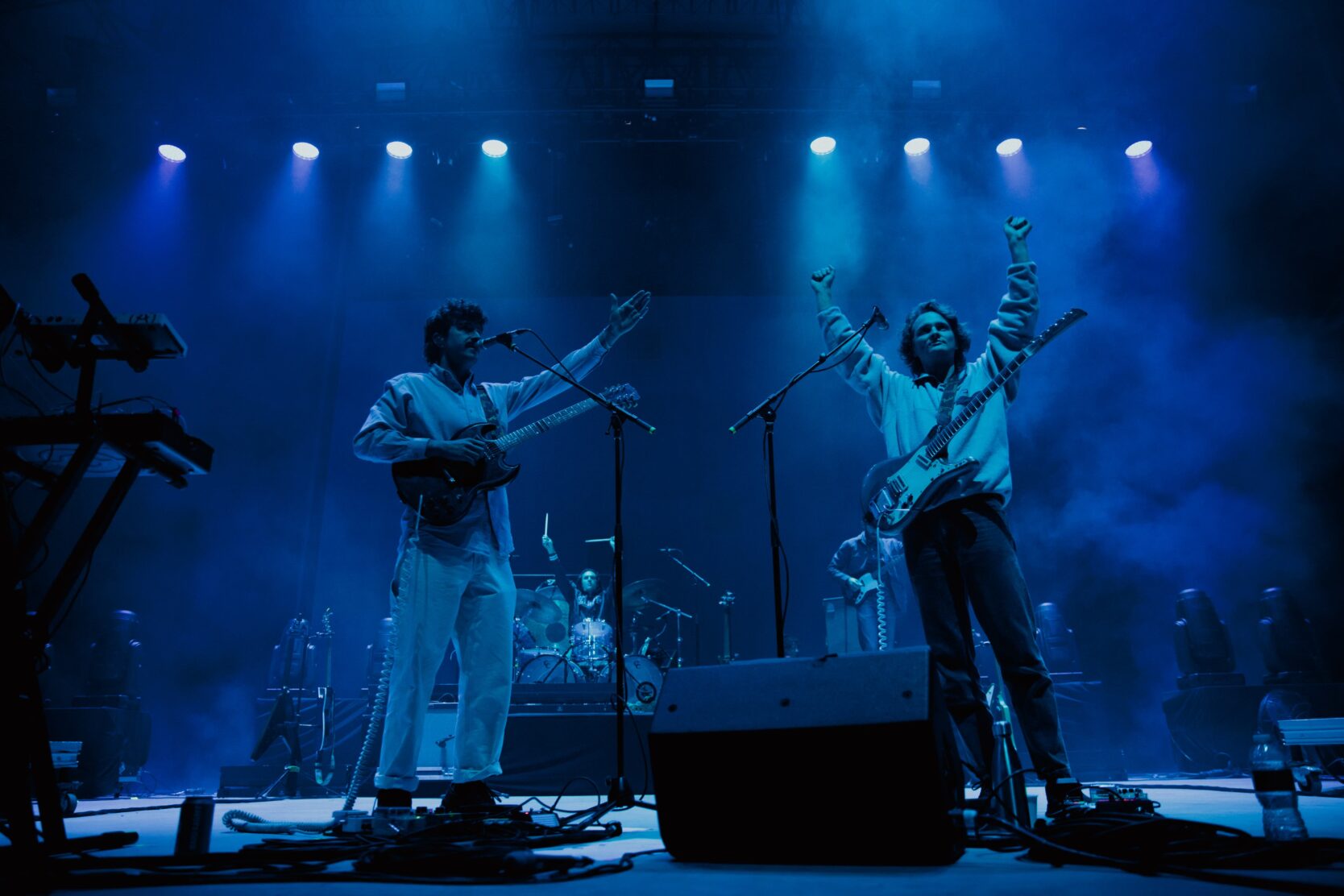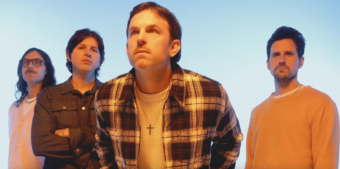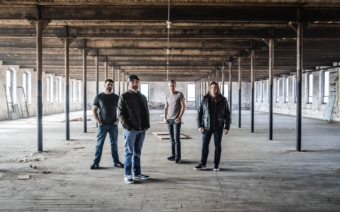The unnaturally blue waters of Southern California’s Lake Perris would be difficult to forget under normal circumstances, but the fact that they’ve (artificially) come to rest in the middle of a desert makes them both an improbable and ideal setting for America’s largest psychedelic rock festival.
The 2022 edition of Desert Daze is where Tame Impala has chosen to perform Lonerism in its entirety for the first time in honor of its 10th anniversary, and where esoteric acts such as Cortex, L’éclair, Witch, Fuzz, and Frankie and the Witch Fingers are greeted like visiting royalty. The festival is also where King Gizzard and the Lizard Wizard is beginning its fall tour, a run that will visit the biggest North American venues of the band’s 13-year career.
From humble beginnings as a goofily named, “hey, why not?” college project in Australia to releasing 23 different genre-jumping albums since 2009, King Gizzard has suddenly become one of the most talked-about bands in rock, seized upon by jam band-loving Gen Z stoners, Metallica and Tool devotees jonesing for like-minded heavy riffage, suburban dads still holding a candle for AC/DC and Pink Floyd, and Discogs-loving record nerds perpetually in search of the next great buzz. At a time when many established artists can’t make the economics work to tour at all and many listeners cling to the notion that “rock is dead,” there’s something quite extraordinary about what King Gizzard is doing.
None of this would be possible without the rapidly expanding Gizzard fan base, whom the band allows to reimagine its live shows, merch, and even select official releases through a sanctioned Bootlegger program and then sell through its Gizzverse store. The momentum has also been fueled by Gizzard’s increasingly jammed-out concerts, which frontman Stu Mackenzie curates with the help of detailed, color-coded spreadsheets and the website Setlist.fm to ensure they’re never the same from night to night.
The King Gizzard discography is as diverse as it is daunting. The band’s albums touch on lo-fi garage-y jams, Krautrock, metal, prog, psychedelia, non-Western microtonal instrument tunings, modular synthesizer-dominated electronic pop, and everything in between (often in the same song). The material, in turn, is populated by beguiling characters such as unfriendly garden goblins, genocidal robots, organ farmers, boogiemen, altered beasts, rattlesnakes, and Death itself (who turns out to be a pretty decent rapper when possessed by the human spirit of group member Ambrose Kenny-Smith). In concert, the band loves to weave and tease bits of different songs into and out of one another, unifying its body of work in a way that invites deep exploration and Dead/Phish-level fan analysis.
Box office numbers further tell the story for a group not that far removed from playing its first U.S. show to a sparse crowd at the 250-capacity Baby’s All Right in Brooklyn in 2014: more than 27,000 tickets sold for three marathon, three-hour shows at Red Rocks outside Denver (for a total of eight-plus hours of music with no repeats with over 80 different songs performed) and 8,500 more at New York’s Forest Hills Tennis Stadium, the largest North American venue Gizzard has headlined to date. And while details are still being finalized, a novel touring concept will bring the band to even bigger U.S. crowds in the summer of 2023 without losing sight of this time-tested, fan-first approach.
“The pandemic has definitely not slowed down the band’s work ethic,” says Panache’s Michelle Cable, who has booked Gizzard since 2013 and managed it since 2020. “Their constant musical output, matched with their fan engagement across the Gizzverse and social media, plus the momentum of returning to audiences after not having been able to tour for more than two years, has all really contributed to this explosive fan growth. They have always dared to operate differently, so it makes sense that they are accelerating at full speed while others might be hitting pause.”
“The band has grown so much. It’s just wild how many people come to see us play these days,” Mackenzie says. “But overwhelmingly, it has been a gradual, year-by-year increase. There’s no particular record that has exploded. There are some in hindsight that people love, but it’s never happened in real time. It’s not like we’ve won major awards, had songs on the radio, or done television performances. We don’t have those moments. Maybe there’s something nice about it being gradual, to be honest.” He adds with a laugh, “it makes it all feel more manageable and like I’m not losing my mind.”
While Mackenzie is doing his best to keep Gizzard’s rise in perspective, fans like Ezra Gray, a 24-year-old record store employee in Boston, are more than happy to dive headfirst into the Gizzverse with abandon. Gray got into the band in what she calls “a low-key sort of way” in 2019, but thanks to pandemic-era boredom and under-stimulation, revisited the music the following year and promptly “fell head over heels. I would pick an album, listen to it nonstop for a week while slogging through remote art school, and then move on to the next one. It filled a void that had been left by going to shows, and it led to me making a lot of friends online. I also really appreciate the Bootlegger program and how it encourages creativity and innovation in a way that not many other bands do.”
Fans old and new have enjoyed an embarrassment of Gizzard riches of late. The Sept. 30 Desert Daze gig takes place a week before the band brings forth Ice, Death, Planets, Lungs, Mushrooms and Lava, the first of three distinct releases in October (upping the 2022 total to five studio albums). Cell phones barely work at this out-of-the-way locale, and as Gizzard takes the stage 30 minutes before midnight, fans are moshing within seconds of the doom-y, Sabbath-on-trucker speed rocker “Gaia.” The band proceeds to pummel the crowd with two headbangers from the 2019 thrash metal homage Infest the Rat’s Nest, a Gizzard gateway drug of an album for many hard rock-adjacent listeners. Gizzard also offers up the live debut of Ice, Death’s simmering, nine-minute “Iron Lung,” built, like the album’s other six songs, from hours of uninterrupted jamming and instrument switching in a modus operandi the band had never previously pursued with such zeal.
During the middle of the set’s final song, “The Dripping Tap,” Mackenzie strips down to his boxers, crowd-surfs through the sizable audience, and takes a pitch-black dip in the lake, somehow making it back on stage before the last chord is struck. Minds are blown and devil horns are raised, undaunted by the long, chilly, and dimly lit walk back to the festival campground.
Outside the band’s trailer, beers are cracked ahead of a seven-hour bus ride to the Bay Area, where the three-hour marathon set concept will be debuted the following night at Berkeley’s Greek Theater. Mackenzie appears snug in a fleece Patagonia pullover, but his light brown hair is still wet from the lake as he toasts the Gizzard crew, who’d dispersed six weeks earlier in Europe. “This is just the beginning,” says multi-instrumentalist Joey Walker, whose mustache-forward movie star looks and fancy dance moves were put to hilarious use in the video for the new song “Ice V.” “We only had two days to rehearse before this tour started. We’re not even warmed up yet.”
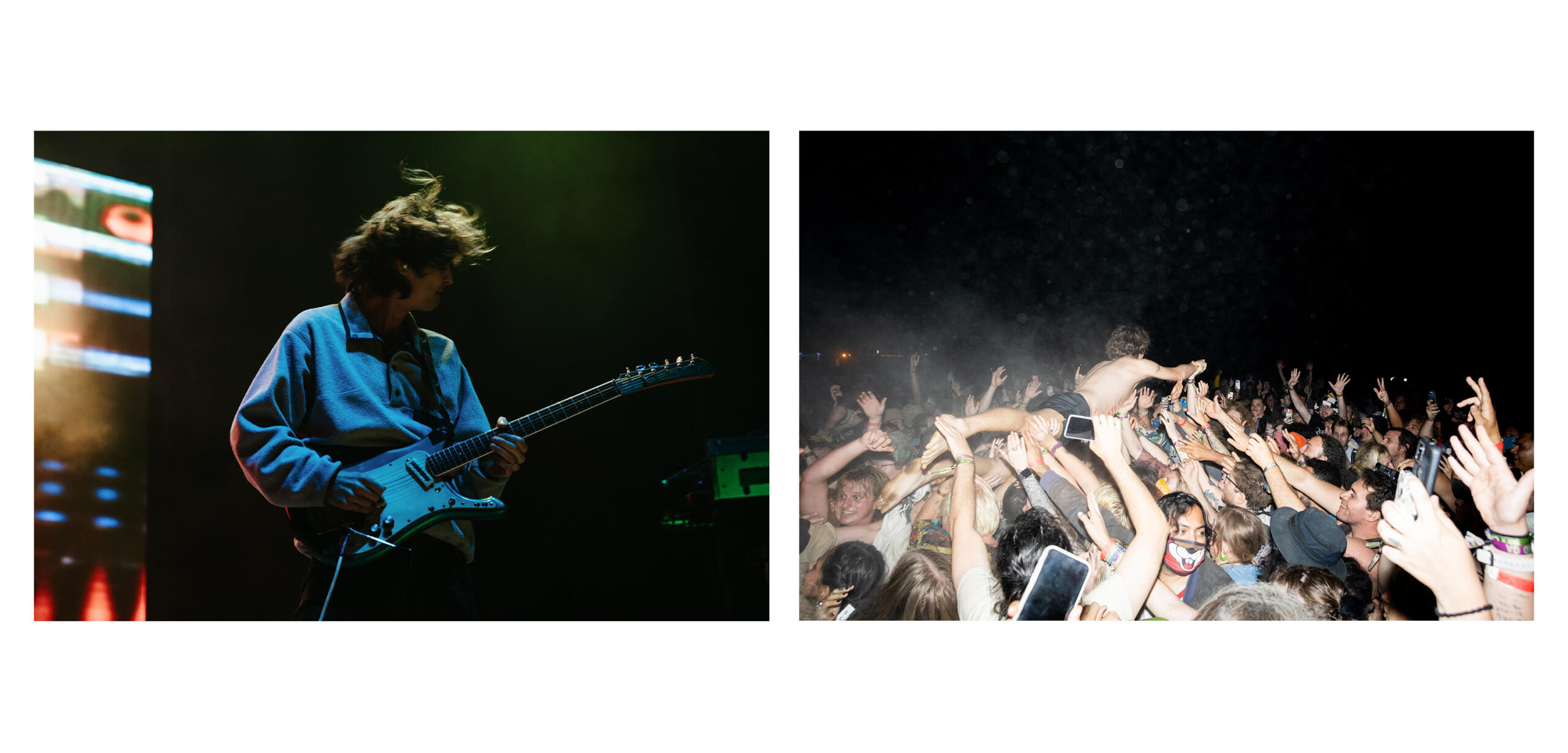
***
Ten days later at Denver International Airport, something Gizzard-y is most definitely in the air, with scores of fans retrieving their Gizzard sticker-covered luggage from baggage claim and shooting the breeze outside while waiting for rental car shuttles. During a Mexican lunch at the foot of Red Rocks in nearby Morrison, a table of Gizzard diehards debate what is the heaviest album in the band’s discography (the consensus seems to be a tie between Rat’s Nest and 2016’s whiplash-inducing Nonagon Infinity). On the way into this impossibly beautiful venue carved into the Rocky Mountains, carloads of fans with audible Australian accents park on the side of the road to tailgate and gaze out at the pink- and orange-tinted sunset.
These Red Rocks shows are a long time coming, having been booked in the waning pre-pandemic months of 2019 only to be postponed three times due to COVID. At first, only two were announced, but they sold out in just 48 hours, prompting the band to tack on a third non-consecutive night on Nov. 2 as the finale of the fall run. “What the fuck are we doing here?” Walker marvels from the stage at one point during the first show, recalling his teenage viewing of an Incubus concert DVD taped at the amphitheater. “I can’t feel my legs!” Kenny-Smith shouts.
Over the course of 27 songs drawn from 13 different albums, Gizzard rocks the packed house nearly senseless. The second set’s opener, “Rattlesnake,” teases five other of the band’s songs, three of which are then played in full. The music is personable, complex, inventive, and adherent to a totally unique internal logic that has somehow translated into selling the equivalent of two arenas’ worth of tickets here.
Backstage, the group is unabashedly emotional about the achievement, calling it “deeply surreal.” Says Walker, “I made a conscious decision to try as hard as I could to take it in, because sometimes it can be hard to look up when you have such a big show. I was really trying to see the scale of the whole thing. It just kept going! Everyone was so overwhelmed by the fact that we were able to play this venue, let alone sell it out.”
“After Nonagon came out in 2016, we did two years of constant touring, and 80% of the setlist was Nonagon songs. We got a bit bored with that and made a conscious decision to expand the tour repertoire because we had all these albums but were only playing such a small percentage of songs from them live,” bassist Lucas Harwood says when asked how Gizzard’s live show has evolved over the past few years. “If you’d have told me then that in 2022, we’d be doing three, three-hour sets at Red Rocks with no repeated songs, I’d have had a panic attack. Luckily, we’ve had years to think about it.”
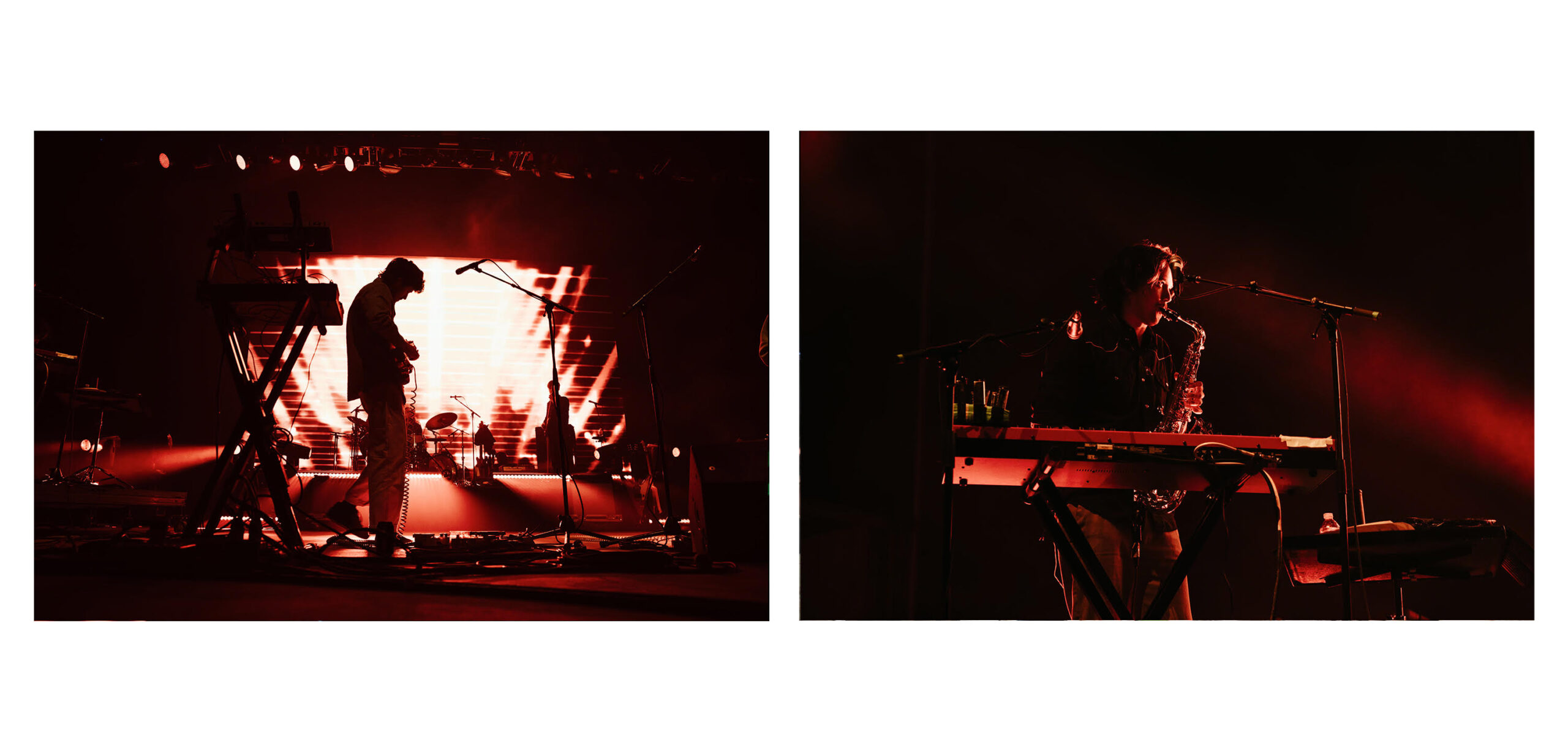
After enjoying a Bud Light or two and saying hi to some friends, the band exits through a Red Rocks now completely empty except for a very large raccoon happily munching trash left behind under the seats. By the next morning, there’s no escaping the specter of Gizzard throughout the greater Denver metropolitan area. In a jarring switcheroo from its usual Muzak-y selections, the hotel is playing a Gizzard album over the lobby sound system. Before showtime at the venue later that day, people are singing, almost involuntarily, the titular phrase of “Ice V” out loud to nobody in particular. A group of young folks are dressed in nun habits.
One fan tells another how excited she is to cover a cigarette burn in her jacket with a Gizzard patch, while hundreds wait up to 45 minutes in line for Red Rocks-specific merch as well as vinyl copies of Laminated Denim, a superb new two-song, 30-minute album composed especially for the occasion (Walker’s Alex Lifeson-ish guitar riff at the 5:30 mark of “Hypertension” is one of the most sublime moments ever put to tape on a Gizzard release).
“We’re running hot tonight,” Walker says a few songs into the first set of night two. “Maybe it’s because it’s my birthday.” Having already been presented with shots on a tray the evening before, Walker tonight receives an on-stage cake, and later, refills of tea and champagne poured by his girlfriend Edith, who also happens to be Kenny-Smith’s sister. With no open area for moshing, the crowd is instead tossing around a seemingly bottomless supply of inflatable sharks and alligators, giving the whole event an air of smiley, kind bud-addled otherworldliness.
Gizzard blazes through 31 more songs that span 15 different albums, its astonishing instrumental virtuosity matched only by its commitment to putting on an unforgettable show. Opening act Leah Senior runs onstage after the finale of “Mr. Beat” to douse the band with silly string, making them appear as if they’re covered in melted wax. The extremely stoned, bleached blonde hippie next to me finally utters his first sensible thought of the evening: “After you played that show, you don’t have to do an encore.” Amen, brother.
“That felt like a dream that didn’t actually happen,” Mackenzie says afterward, lounging barefoot amid five bandmates who are in various states of coming down from a major adrenaline high. Walker’s girlfriend is asleep on the floor, while drummer Michael “Cavs” Cavanagh is staring simultaneously into space and at his phone. Oxygen tanks are at the ready, in case the extreme mountain altitude becomes a bit too much, and Walker’s mostly eaten chocolate birthday cake beckons from the craft services table. We step outside for a smoke with multi-instrumentalist Cook “Cookie” Craig, who can’t help but wonder aloud what it is about Gizzard’s music that is now connecting with so many new listeners.
“We’ve got more than 20 albums, so there’s something in there most people can like,” he says. “I wonder sometimes if there are metal-heads who come to the gig and leave shattered because we didn’t play that many metal songs [Laughs]. Some people love it for that same reason — it’s a mixed bag, but hopefully it’s all in the same universe. We’re definitely leaning more into the jammy shit, because we do it a lot more live now. It’s fun and people seem to like it. I think it’s a balance of doing it and not being too self-indulgent.”
With 58 tracks off the table for the third Red Rocks show, Mackenzie says he’s already put some songs aside for that set but admits, “I’m sure it will come together typically last minute. We actually re-wrote a lot of the night two set on the day. We had an original set list, but we changed it up pretty significantly based on how we were vibe-ing at the first one.”
“What a surreal, crazy thing,” he continues. “How did we play to almost 10,000 people two nights in a row in the middle of nowhere Colorado? It’s such a beautiful, amazing, and spiritual place. It feels so deep, not only with the musical history but the actual history. It was very cool to tap into that.”
Returning to the hotel, it’s by this point no surprise that the only people still warming themselves around the outdoor fire pit are Gizzard fans, one of whom has a Nonagon Infinity tattoo. The next morning at the airport, a hirsute fellow in a Gizzard sweatshirt is proudly carrying around a drum head autographed by the band. Next stop: New York, where Mackenzie and company have something truly special in store before the show even starts.
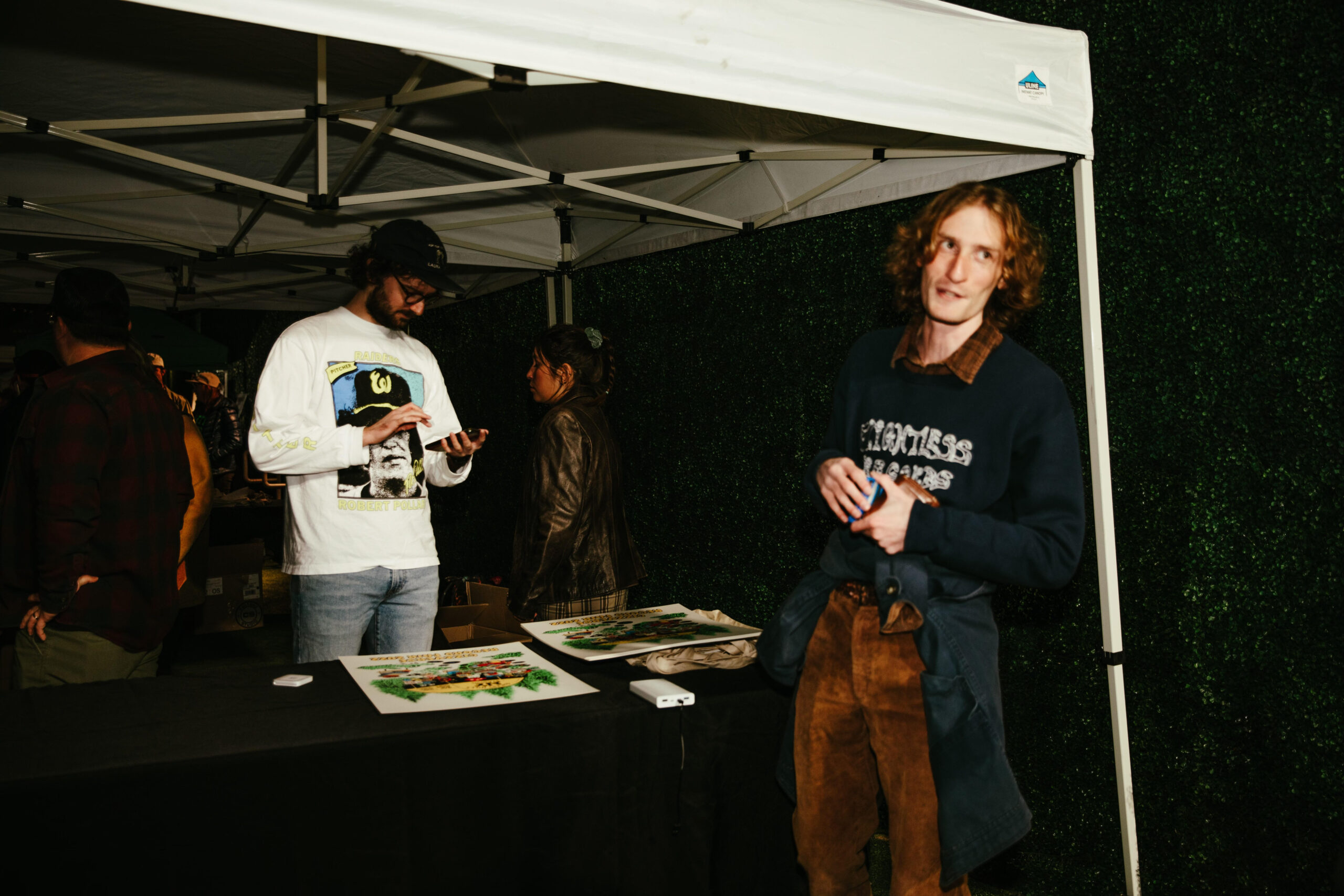
***
King Gizzard’s 85,000-member strong Reddit feed is often dominated by discussion of official and unofficial merch, some of which is made as a labor of love by fans themselves and then traded or sold throughout the community. “With the Bootlegger program, the idea is that you can download all the assets,” Mackenzie says. “You can change the artwork if you want to. You can mix and match songs from different shows. You can press tapes or vinyl or CDs. You just have to send us some to sell in our store. It’s amazing to see how creative people have been with it.”
Alongside unlabeled test pressings, limited-edition boxed sets, and other vinyl rarities, many of these items are available for purchase in one place for the first time at the inaugural Gizzverse Record Fair, a fitting appetizer to the band’s Forest Hills performance on a beautiful late October evening in Queens. Hundreds of fans are lined up at the venue four hours before gates open at 5:30 p.m., and once inside, they make a mad dash to three separate merch lines to peruse the wares, fill their poster tubes, and stuff their Jason Galea-designed, event-specific tote bags with hot Gizzard wax.
Many people are traveling in their own bespoke Gizzard parties, and the diversity of races, ages, and genders is a testament to the inclusive nature of the fan base at large. An emo-looking teenage kid and his stylish, gray haired-dad walk away with seven LPs, politely declining to answer questions because they’re already late to get a spot on the stage barricade. Two 20-somethings with painted faces and color-coordinated capes tell me as they’re pooling their cash, “we’ve met so many other fans through King Gizzard. One was giving out charm bracelets with song titles on them. If we had the money, we’d make patches and hand them out to people too.”
Nearby them is Joe Bieber, an enthusiastic, fleece-clad redhead from upstate New York whose rapidly dwindling bank account is codenamed “Gizzfund.” “The band performed a two-night residency in Burlington earlier this year, and through that, I met 10-15 people I’d now say are my friends — people I’ve stood in Gizzard lines with for four hours,” he says while carefully packing his vinyl haul into a cardboard box. “Most kids nowadays are socially anxious, but this scene promotes positivity. It’s cool to be around so many different types of people giving off that collective energy. If you do things you enjoy, people will eventually enjoy them too.”
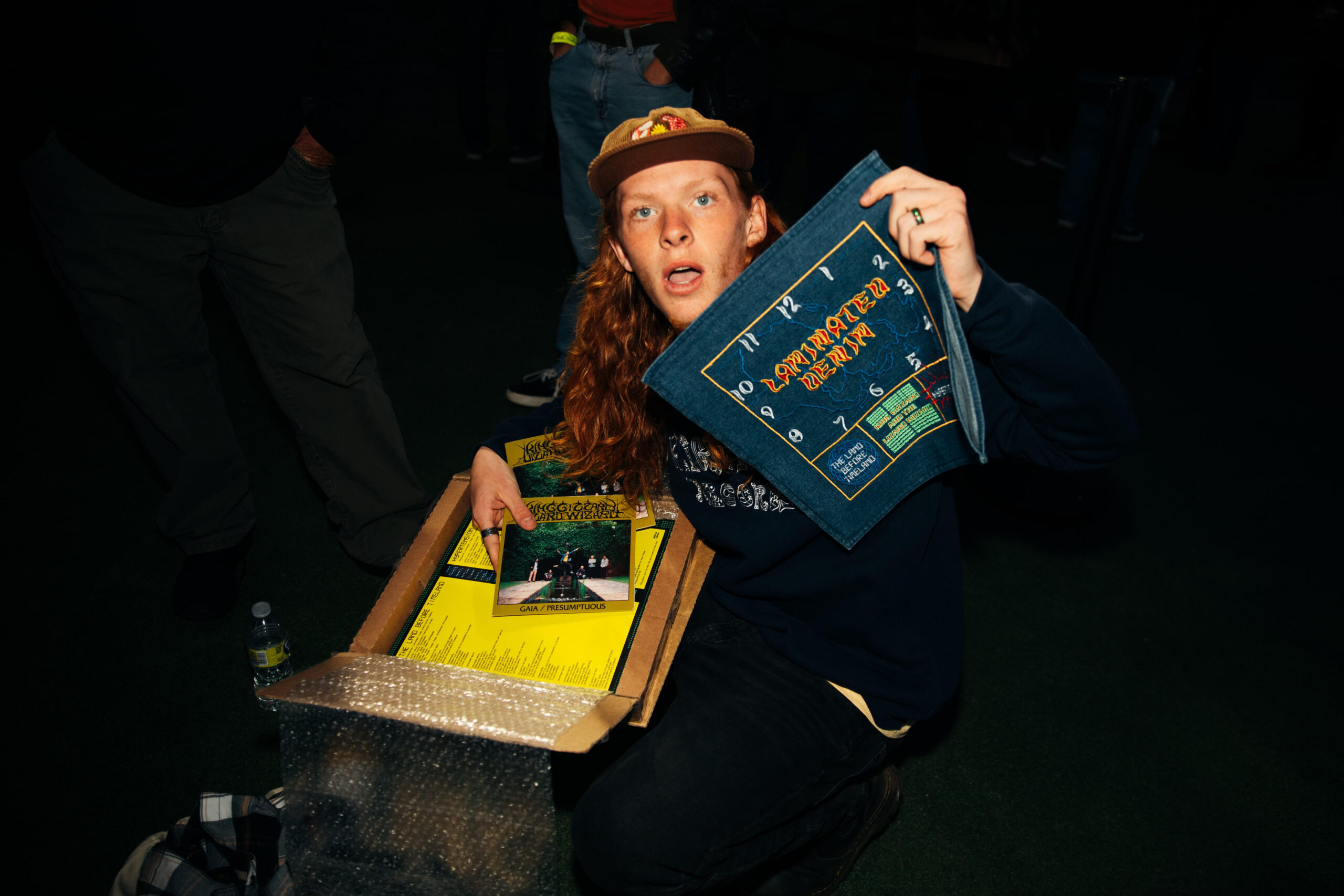
It’s a sentiment shared by the members of King Gizzard, who say they could not have cultivated this type of intense band-to-fan connection even if they’d tried. “I feel like we gained these fans by just doing what comes instinctually and naturally to us,” Walker says. “Maybe the nature of how we operate and that extra element of the Gizzverse, coupled with us constantly putting out music, worked in our favor during the pandemic. People could still think and talk about us. It didn’t slow down in that respect. We’re known for our live shows and we love playing, so maybe after the break, people were even more excited to come see us. Or if they hadn’t yet, now they were ready.”
“I think you’re right,” Harwood replies. “During the pandemic, I reflected on a lot of things, and I got pretty sad and depressed about concerts being halted. We still put out a lot of music, but playing live had to be put on hold at the apex of our career. I was really doubtful we could pick up where we left off, but I’m so grateful that we’ve been able to explode back onto the scene.”
That explosion is quickly felt in the audience at Forest Hills, despite band members being a bit worse for the wear after their first in-person professional hockey game the night before at New York’s Madison Square Garden (their antics even made it onto the Jumbotron). The bottom end to the intro of the new song “Lava” is so loud that it physically rattles the body, while “Magenta Mountain” morphs from genial, Ween-ish vibes to an extended closing jam of almost apocalyptic heaviness. “Iron Lung” is again the closer, as a leather jacket-clad Kenny-Smith prowls the foot of the stage like a jungle cat waiting to strike and shouts about “frog breath” and “neck paralysis” at the top of his lungs. “I don’t wanna leave New York City,” Mackenzie tells the crowd, many of whom break out into coordinated rowing movements amid the mosh-crazy general admission floor. “I fuckin’ love this place.”
Eagle-eyed jam band fans spot Phish’s Trey Anastasio and Goose’s Peter Anspach rocking out at the show, further shrinking the Venn diagram between Gizzard and its more traditional jam band-leaning brethren. “We’re living in the moment catching one of the best bands (ever!) in their prime,” enthuses a Reddit fan after the show. Adds another, “At this point, lacking a better explanation for how six dudes who each wear music like an extension of their bodies, plus are all down for crazy ass ideas, managed to all be in the same place at the same time and form this band … I’m going with: they are aliens.”
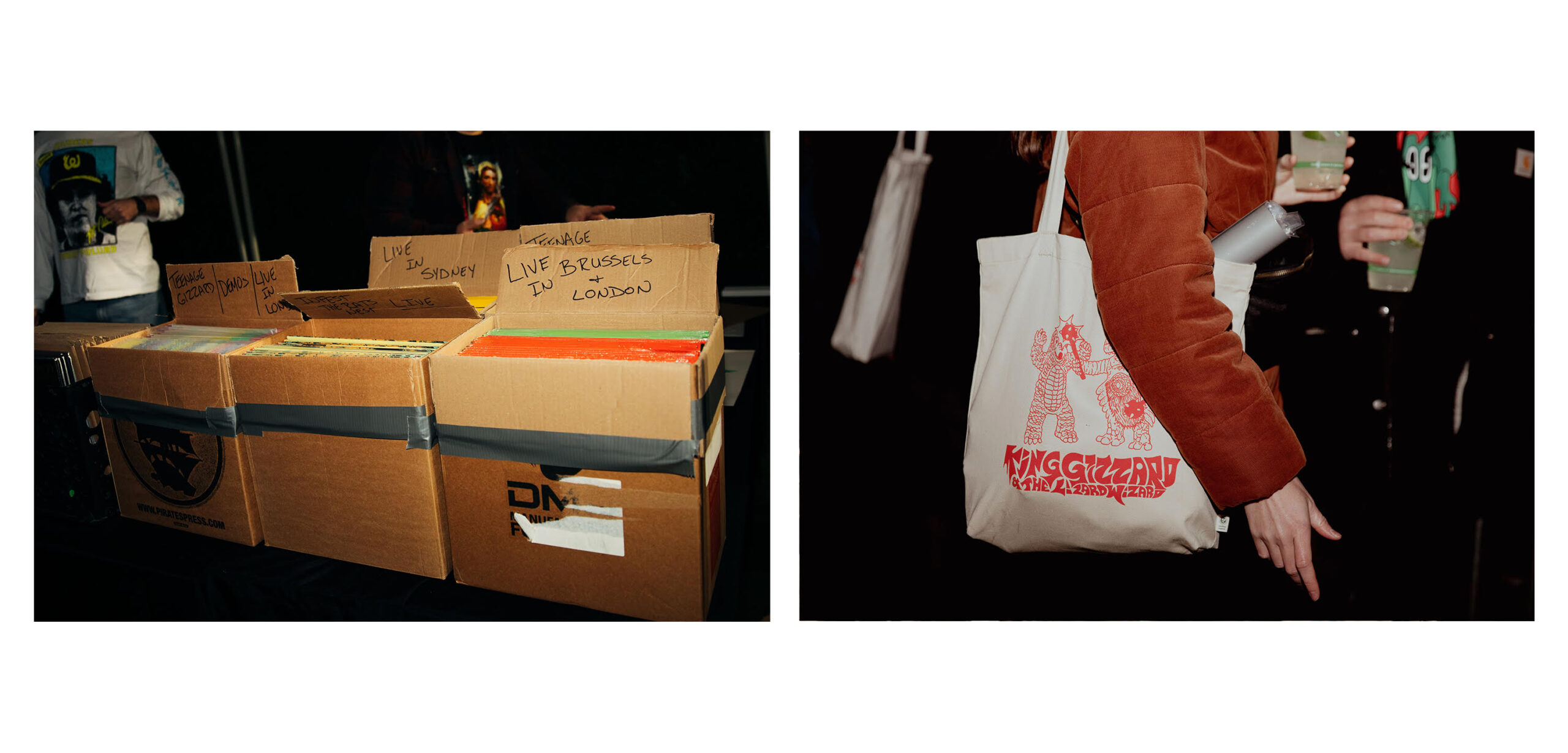
***
With live shows like this, it can be easy to lose track of Gizzard’s recorded output. Luckily for the listening public, the last album of the October arrivals is also one of the band’s most distinctive. Unlike its freshly released siblings, Changes was meticulously constructed part by part rather than originating from jams, and its purposefully constrained usage of only two specific chord changes results in a compelling hegemony of R&B-leaning sound. Started in 2017 and finally completed this summer, it’s an outlier in the Gizzard catalog – contemplative, guitar-free for long stretches, and never in any particular hurry, with a feel ranging from the hyperactive, claustrophobic “Gondhi” to the whimsical, funky “Astroturf,” and the resigned “Exploding Suns,” which floats along and fills the lungs like pre-dawn haze rising from dewy ground.
“Changes is like the amalgamation of the last five years of writing,” Mackenzie says. “It feels really good to get it out. I think people are going to be confused when they hear it because I think they expect it to be a really jam-packed, five-years-in-the-making, crazy thing, which in some ways it is, but in a lot of ways, it’s not. We didn’t go into it thinking it would be an R&B album – it just happened.” A short film chronicling the making of the album, Sleeping Monster, is available for on-demand streaming through Vimeo.
One benefit of releasing five albums in 2022 is that the proverbial Gizzard backlog is cleared, allowing the group to “go back to the studio and approach writing from a nice and fresh perspective without all these other ideas that are unfinished in the back of our brains,” according to Mackenzie. Adds Walker, “conceptually, a couple of things have been mapped out that we’ll dive headfirst into when we get home. As far as stuff that’s locked and loaded, there actually isn’t a huge amount. That’s kind of weird for Gizzard, but it’s just due to how long we’ve been out on the road this year.”
For now, the band will continue to indulge its wildest creative impulses, comforted by the knowledge that the Gizzard fanbase is poised to keep growing and evolving right along with it every step of the way.
“In terms of the way we’ve played our cards, we’ve definitely done everything you’re not supposed to do, and we haven’t been strategic in any formal way,” Mackenzie says with a hint of pride. “We’re just making our weird music and for some reason, people keep coming to see us. There definitely is a bit of a feedback loop with the fans, especially the ones who come to multiple shows — the familiar faces we see almost every night of the tour. What’s good for us is what’s good for them too, and it has made us more creatively fulfilled than we have been.”

